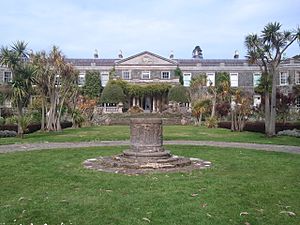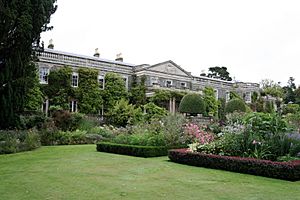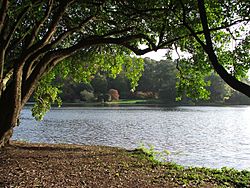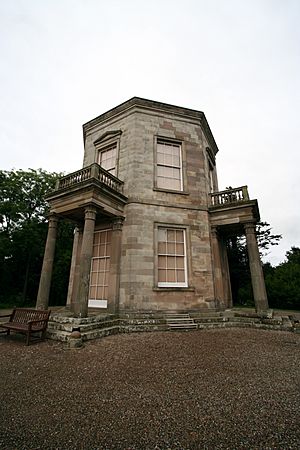Mount Stewart facts for kids
Quick facts for kids Mount Stewart |
|
|---|---|

Mount Stewart, April 2011
|
|
| Built | 1820–1839 |
| Built for | Marquess of Londonderry |
| Architect | George Dance, William Vitruvius Morrison |
| Owner | National Trust |
|
Listed Building – Grade A
|
|
| Designated | 20 December 1976 |
| Reference no. | HB24/04/052 A |
| Lua error in Module:Location_map at line 420: attempt to index field 'wikibase' (a nil value). | |
Mount Stewart is a beautiful house and garden in County Down, Northern Ireland. It was built in the 19th century and is now looked after by the National Trust.
The estate sits on the eastern shore of Strangford Lough, close to Newtownards and Greyabbey. It was once the home of the powerful Stewart family, who were also known as the Marquesses of Londonderry. The house and its treasures tell the story of this family's important role in British and Irish history.
Mount Stewart's Story
The Stewart Family Home
The story of Mount Stewart began in 1744. That year, Alexander Stewart bought the land, which was then called Mount Pleasant. The Stewarts were a wealthy family of farmers and linen merchants. Their money grew even more when Alexander married the sister of Robert Cowan, a governor in India.
The Stewarts became very important in the area. In 1795, Alexander's son, Robert Stewart, became the Earl of Londonderry. Later, in 1816, he became a Marquess. His son, also named Robert Stewart, Viscount Castlereagh, became a key political figure.
Castlereagh helped unite Ireland with Great Britain in 1800. He then served the new United Kingdom as a Foreign Secretary. He played a big part in forming alliances that helped defeat Napoleon.
In 1803, Castlereagh hired the architect George Dance the Younger to redesign parts of the house. He wanted to create new reception rooms in a grand Neoclassical style. Some of the furniture you see today reflects Castlereagh's career. This includes a portrait of Napoleon and special chairs made for the leaders who redrew the map of Europe at the Congress of Vienna.
Mount Stewart During the 1798 Rebellion
In June 1798, during a time of rebellion in Ireland, Mount Stewart was briefly taken over by a group called the United Irishmen. The Stewart family was involved in the events that followed.
The Vane-Tempest-Stewarts Take Over
After Castlereagh passed away in 1822, his half-brother, Charles Vane, 3rd Marquess of Londonderry, became the owner. He had been an ambassador in Europe. He married Lady Frances Anne Vane-Tempest, who was very rich. To honor her, he changed his name to Robert Vane and made the house even bigger.
During the Great Famine in 1847, the Marquess spent a lot of money on house renovations. However, he gave very little to help his struggling tenants. In contrast, his wife, the Marchioness, was much kinder. She lowered rents for her tenants and even cancelled them completely for those badly affected by the potato blight.
The house's current look comes from this time. The original Georgian building was changed, and the house grew to eleven sections. A huge entrance porch was added to the front.
The marriage also brought a lot of land and coal mines in England to the family. The couple bought other grand homes, including Wynyard Park, County Durham and Londonderry House in London.
Later, the 4th and 5th Marquesses lived in other family homes. This meant Mount Stewart was sometimes neglected for long periods.
A Center for Unionist Politics
Charles Vane-Tempest-Stewart, 6th Marquess of Londonderry (1852–1915) returned to Mount Stewart. He and his wife, Lady Theresa Vane Tempest Stewart, became leaders in the movement against Irish Home Rule. They led the Ulster Unionist Council and the Ulster Unionist Women's Council.
Lady Londonderry was well-connected and a great organizer. In 1903, she hosted Edward VII and Queen Alexandra at Mount Stewart. She also helped prepare for armed resistance against a Dublin parliament. She even offered Mount Stewart as a hospital site for the Ulster Volunteers.
A Visit from Germany's Ambassador
In 1921, Charles Vane-Tempest-Stewart, 7th Marquess of Londonderry, became the Minister of Education in Northern Ireland. Later, in 1935, he had to leave his role as Air Minister in London. He was seen by some as an "appeaser" for trying to make peace with Hitler's Germany.
In May 1936, after visiting Hitler in Berlin, he invited the German Ambassador, Joachim von Ribbentrop, to Mount Stewart. Ribbentrop arrived with a group of SS men, and the visit became a big news story.
The house still has a small porcelain statue of an SS flag bearer. This was a gift from Hermann Göring. It was kept even after World War II began. The 7th Marquess passed away at Mount Stewart in 1949. He is buried in the family graveyard on the estate.
The 7th Marchioness, Edith Halen Chaplin, was inspired by her ancestral home's gardens in Scotland. She redesigned the gardens at Mount Stewart with different themes. These included the Italian, Spanish, and Mairi gardens. She also created the Dodo Terrace with its fun animal statues. Lady Edith also redecorated much of the house's inside.
Given to the National Trust
Lady Mairi Bury, the last child of the 7th Marquess, gave Mount Stewart and most of its contents to the National Trust in 1977. She was born in the house and was the last family member to live there full-time. Lady Mairi passed away at Mount Stewart in 2009, at the age of 88.
Mount Stewart Today
The National Trust now manages the 50-acre property. It is known as "Mount Stewart House, Garden & Temple of the Winds." In 1999, the gardens were considered for a UNESCO World Heritage Site listing.
In 2015, the National Trust finished a big project to restore the house and its contents. They also bought an extra 900 acres of land that used to be part of the estate. In January 2025, a strong storm called Storm Éowyn caused a lot of damage. Over 10,000 trees were lost, including many old and important ones.
The House
The house you see today is mostly thanks to the 3rd Marquess. Starting in the 1830s, he updated and expanded the original 18th-century building. He added a large entrance with Ionic columns. Two domes were also added to bring light into the main hall and another room.
A new set of rooms was added, with the Drawing Room being the most important. It looks out onto the main gardens. The house's private chapel was added after the 3rd Marquess died in 1854, in his memory. It has beautiful stained glass windows and Italian paintings.
The National Trust's restoration in 2015 aimed to make the inside look like it did in the 1950s. This was when Lady Edith, the seventh Marchioness, lived there. However, the main hall's checkered stone floor, laid by the 3rd Marquess, was uncovered and restored.
The Gardens
The 7th Marchioness, Lady Edith, completely redesigned the gardens. She took advantage of the mild and humid climate of the Ards Peninsula. This special weather allows many tropical plants to grow well outdoors.
Before her husband became Marquess in 1915, the gardens were mostly plain lawns. Lady Edith added the Shamrock Garden, the Sunken Garden, and made the lake bigger. She also created a Spanish Garden, an Italian Garden, and the Dodo Terrace with its fun cement animals. She realized how perfect the local climate was for tender tropical plants. In 1957, she gave the gardens to the National Trust.
Temple of the Winds
The Temple of the Winds is a unique octagonal building that overlooks Strangford Lough. It was designed by architect James 'Athenian' Stuart in 1782–83. He was inspired by an ancient building in Athens called the Tower of the Winds. This tower had carvings of the eight wind gods from Greek mythology.
Many grand houses in the UK have similar "temples." These were inspired by buildings their owners saw during their travels around the Mediterranean.
Filming Location
In 2014, Mount Stewart was used as a filming location for the third series of the BBC children's TV show The Sparticle Mystery. In 2024, it was named one of the top 10 most popular filming locations in Northern Ireland.
See also
 In Spanish: Mount Stewart para niños
In Spanish: Mount Stewart para niños
- Dunduff Castle, South Ayrshire, property of the ancestors of the Stewarts of Mount Stewart
Other homes of the Marquesses of Londonderry:
- Londonderry House in London
- Plas Machynlleth in Wales
- Seaham Hall in County Durham
- Wynyard Park in County Durham
- Loring Hall in Kent




